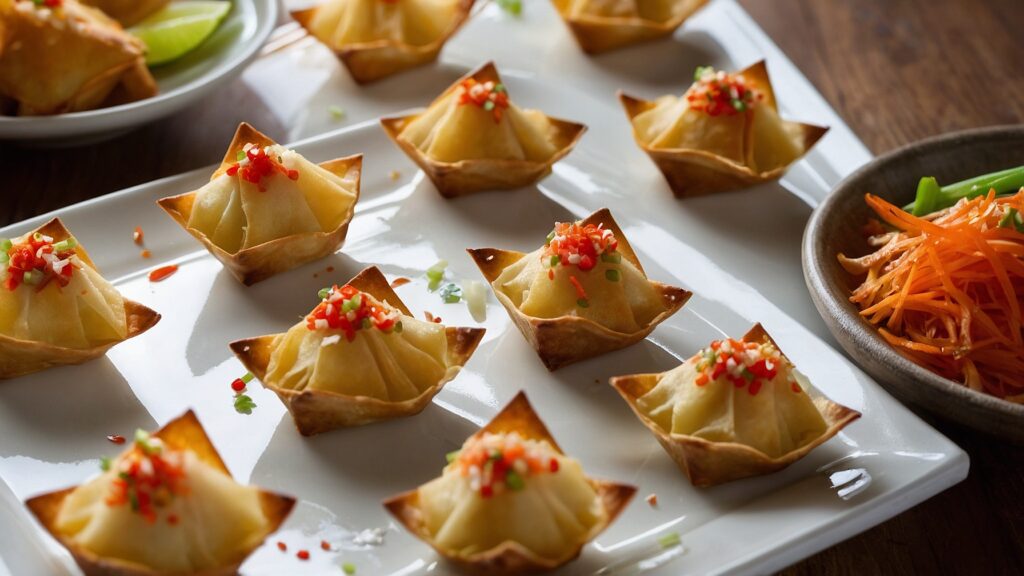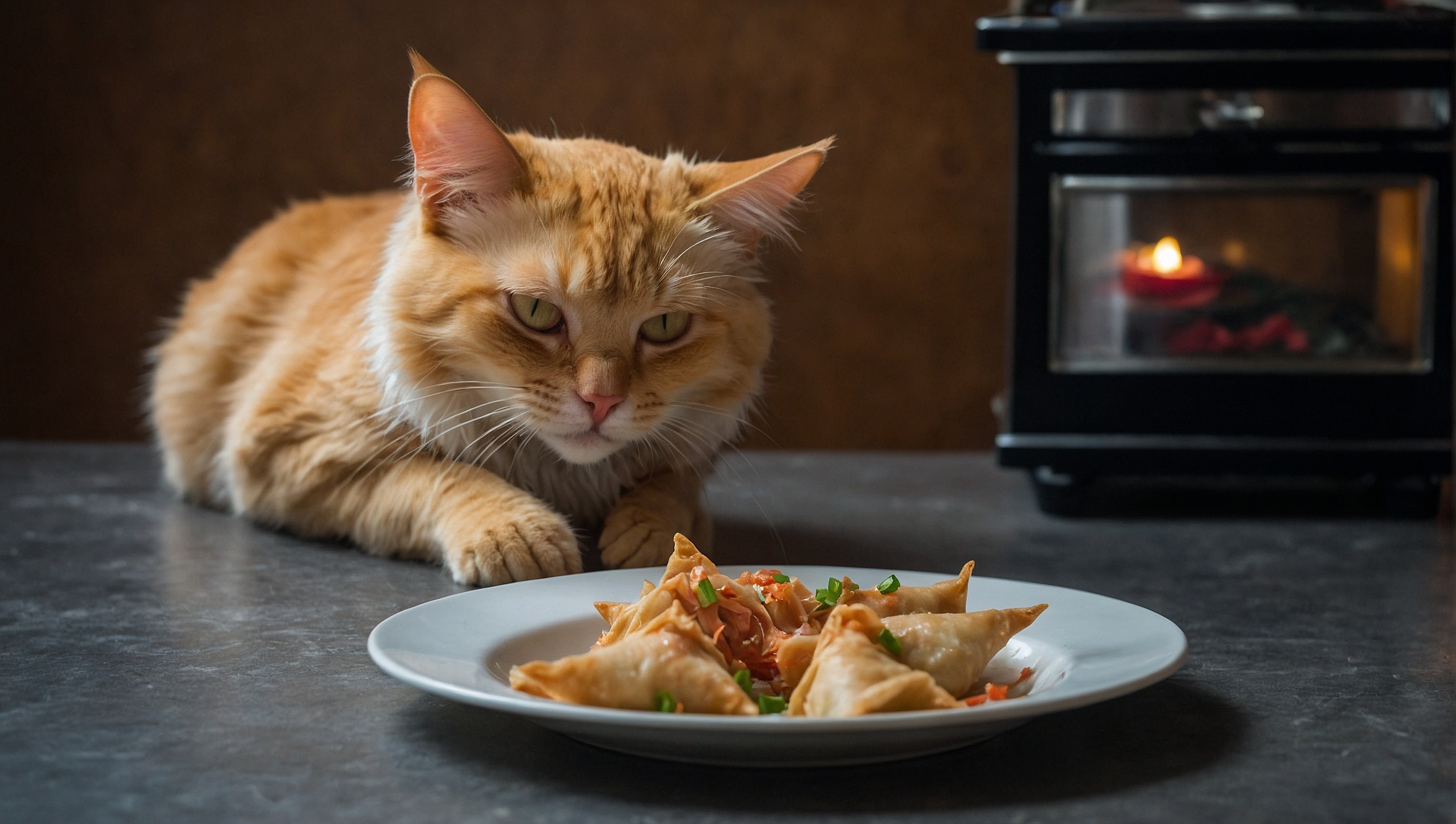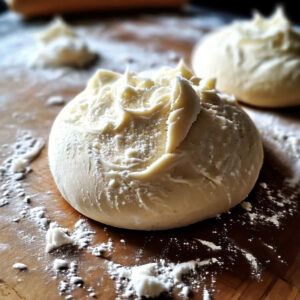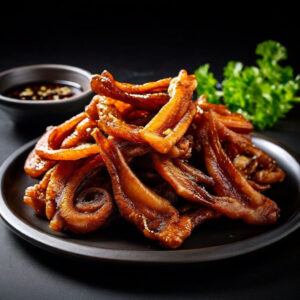Crab rangoon, a popular appetizer consisting of fried wonton wrappers stuffed with a creamy mixture of crab meat (or imitation crab) and cream cheese, is a beloved treat for many humans. However, as cat owners, we must be cautious about sharing our favorite human foods with our feline friends, as certain ingredients can be harmful or even toxic to cats.
While it may be tempting to sneak a bite or two of this savory delight to your furry companion, it’s crucial to understand the potential risks involved. In this comprehensive guide, we’ll dive deep into the question “can cats eat crab rangoon safely?” and explore the reasons why this snack should generally be avoided for our feline companions.
Table of Contents
What is Crab Rangoon?

Before we delve into the safety aspect, let’s first understand what crab rangoon is. Crab rangoon is a popular appetizer found in many Asian restaurants and American Chinese cuisine. It consists of fried wonton wrappers filled with a mixture of crab meat (or imitation crab) and cream cheese, often mixed with seasonings like garlic, onions, and sometimes even Worcestershire sauce.
These crispy, bite-sized treats are typically served with a sweet and sour sauce or a tangy dipping sauce, making them a flavorful and indulgent snack. However, their ingredients and preparation methods raise some concerns when it comes to sharing them with our feline friends.
Can Cats Eat Crab Rangoon? The Short Answer
No, cats should generally not eat crab rangoon due to the potential health risks associated with the ingredients used in this popular appetizer. While a small bite here and there may not cause immediate harm, regularly feeding crab rangoon to cats can lead to various digestive issues, allergic reactions, and even more severe health problems.
Ingredients in Crab Rangoon That Are Unsafe for Cats
To understand why crab rangoon is not recommended for cats, let’s examine the main ingredients and their potential risks:
1. Crab Meat/Imitation Crab
While crab meat itself is not inherently toxic to cats, it can pose some concerns. Firstly, crab meat is often high in sodium, which can be problematic for cats as their bodies are not equipped to handle excessive amounts of salt. Secondly, some cats may develop allergic reactions to seafood like crab, which can lead to skin irritations, vomiting, or diarrhea.
Imitation crab, commonly used in crab rangoon as a more affordable alternative, is made from processed fish products and often contains additives like sugar, salt, and preservatives, further compounding the potential risks for cats.
2. Cream Cheese
Cream cheese, a key ingredient in crab rangoon, is dairy-based and high in fat content. Cats are generally lactose intolerant, meaning they lack the necessary enzyme (lactase) to properly digest lactose found in dairy products like cream cheese. Consuming large amounts of cream cheese can lead to digestive issues such as vomiting, diarrhea, and even pancreatitis (inflammation of the pancreas) in severe cases.
3. Wonton Wrappers/Fried Component
The wonton wrappers used to encase the crab rangoon filling are typically made from refined flour and deep-fried, making them a source of carbohydrates and unhealthy fats that are difficult for cats to digest. Fried foods and dough can cause gastrointestinal upset in cats, and the wonton wrappers also pose a potential choking hazard due to their size and texture.
4. Garlic, Onion, and Other Seasonings
Many crab rangoon recipes include garlic, onion, and other seasonings that can be toxic to cats, even in small amounts. These ingredients can cause damage to a cat’s red blood cells, leading to anemia and other serious health issues.
Risks of Feeding Crab Rangoon to Cats

Based on the ingredients found in crab rangoon, here are some potential risks associated with feeding this appetizer to cats:
- Digestive Issues: The high fat content, dairy, and fried components in crab rangoon can lead to vomiting, diarrhea, loss of appetite, and other gastrointestinal problems in cats.
- Pancreatitis: The high-fat content, particularly from the cream cheese, can increase the risk of pancreatitis, a potentially serious condition involving inflammation of the pancreas.
- Allergic Reactions: Some cats may develop allergic reactions to ingredients like crab meat, dairy, or certain seasonings, leading to skin irritations, respiratory issues, or other allergic symptoms.
- Choking Hazards: The wonton wrappers and fillings in crab rangoon can pose a choking risk, especially for smaller cats or those with a tendency to gulp their food.
- Long-term Effects of an Unhealthy Diet: While an occasional bite of crab rangoon may not cause immediate harm, regularly feeding cats human foods high in fat, salt, and carbohydrates can lead to obesity, diabetes, and other health issues over time.
What To Do If Your Cat Ate Crab Rangoon
If your cat has accidentally consumed crab rangoon, it’s important to monitor them closely for any signs of distress or discomfort. Here’s what you should do:
- Watch for Symptoms: Look out for signs of vomiting, diarrhea, lethargy, loss of appetite, or any other unusual behavior that may indicate digestive upset or an allergic reaction.
- Contact Your Veterinarian: If your cat exhibits any concerning symptoms or you suspect they have consumed a large amount of crab rangoon, it’s best to contact your veterinarian immediately. They may recommend bringing your cat in for an examination or provide guidance on how to manage the situation at home.
- First Aid Tips: In the meantime, ensure your cat has access to fresh water and a quiet, comfortable space to rest. However, do not induce vomiting or administer any medications without consulting your vet first.
Remember, prompt action and veterinary care can help mitigate potential risks and ensure your cat’s well-being.
Safe Alternatives and Cat Treats
While crab rangoon may be off-limits for cats, there are plenty of safe and healthy alternatives you can offer as treats or snacks. Here are some options to consider:
- Cooked, unseasoned lean proteins: Cooked chicken, turkey, or fish (without bones or seasonings) can provide a tasty and nutritious treat for cats.
- Plain, cooked vegetables: Cats can enjoy small amounts of cooked and unseasoned vegetables like carrots, green beans, or pumpkin (in moderation).
- Commercial cat treats: Look for high-quality, protein-rich cat treats made specifically for feline consumption, ensuring they meet your cat’s dietary needs.
- Freeze-dried meat or fish treats: These treats are a popular choice among cat owners as they are high in protein and low in additives.
Remember, any new food or treat should be introduced gradually and in moderation, as sudden dietary changes can cause digestive upset in cats.
Tips for Cat Owners
As responsible pet owners, it’s essential to prioritize our cats’ well-being and ensure they receive a balanced, species-appropriate diet. Here are some tips to keep in mind:
- Verify Food Safety: Before offering any human food to your cat, research its safety and potential risks thoroughly. Many common human foods can be harmful or even toxic to cats.
- Store Human Foods Securely: Keep human foods, especially those containing potentially dangerous ingredients like onions, garlic, or xylitol (an artificial sweetener), securely stored and out of reach of your cat.
- Transition Slowly: If you decide to introduce new cat-safe foods or treats, do so gradually and in small amounts to allow your cat’s digestive system to adjust.
- Consult Your Veterinarian: If you have any concerns or questions about your cat’s diet or the safety of certain foods, always consult with your veterinarian for professional guidance.
By following these tips and prioritizing your cat’s nutritional needs, you can ensure a happy, healthy, and safe environment for your feline companion.
Conclusion
While crab rangoon may be a delightful treat for humans, it’s generally not recommended for cats due to the potential risks associated with its ingredients. The high fat content, dairy, fried components, and potential seasonings like garlic and onions can lead to digestive issues, allergic reactions, and even more severe health problems in cats.
As responsible pet owners, it’s crucial to prioritize our feline friends’ well-being by providing them with a balanced, species-appropriate diet and avoiding sharing human foods that could potentially harm them. By understanding the risks and taking preventive measures, we can ensure our cats remain healthy and happy while enjoying safe and nutritious treats.
Remember, a small indulgence may seem harmless, but regularly feeding cats human foods like crab rangoon can have long-term consequences on their health. It’s always better to err on the side of caution and consult with your veterinarian if you have any doubts or concerns about what to feed your feline companion.
FAQs
1. Can cats eat imitation crab rangoon?
No, imitation crab rangoon is not a safe option for cats either. Imitation crab is made from processed fish products and often contains additives like sugar, salt, and preservatives, which can be harmful to cats.
2. What if my cat accidentally ate a small piece of crab rangoon?
If your cat accidentally consumed a small amount of crab rangoon, monitor them closely for any signs of digestive upset or allergic reactions. If they exhibit concerning symptoms, contact your veterinarian immediately.
3. Are there any human foods that are safe for cats?
While there are some human foods that can be safely fed to cats in moderation, such as cooked chicken or fish (without bones or seasonings), it’s generally best to stick to a balanced, commercial cat food diet and opt for cat-safe treats specifically formulated for feline consumption.
4. Can kittens eat crab rangoon?
No, kittens should never be fed crab rangoon or any other human foods containing ingredients that could be harmful or difficult to digest. Their delicate digestive systems require a carefully balanced diet specifically designed for their growth and development.
5. Is it okay to give my cat a small bite of crab rangoon as a treat occasionally?
While an occasional small bite may not cause immediate harm, it’s generally not recommended to feed cats human foods like crab rangoon, even as an occasional treat. Stick to safe, cat-specific treats to avoid potential health risks.




